STILL LIFE WITH FLOWERS AND FRUIT, c.1851
WILLIAM BUELOW GOULD
oil on canvas
61.0 x 75.0 cm
signed lower right: W.B. Gould Painter
Sotheby's, Melbourne, 21 August 1995, lot 63 (as Fruit and Flowers in a Pedestal Vase)
Private collection, Hobart
Flowers and Fruit, 1851, oil on canvas, 61.5 x 74.0 cm, formerly collection of Charles Lloyd Jones, Sydney, illus. in William Buelow Gould, Australian Gallery Directors' Council and Burnie Art Gallery, Tasmania, 1980, cat. 46, p. 42
Still Life with Flowers and Fruit is a classic example of the art of the Tasmanian colonial artist William Buelow Gould. All are European in origin, chosen for their beauty of form and colour, the whole painting having a richly decorative appeal similar to that of the designs on fine English nineteenth century porcelain, redolent of genteel life. The elegance and peace of Gould's art, however, could not be further from the troubled life he led. The artist was a gambler, a drunkard, and a thief. The contrast is so great that it seems unbridgeable, yet the tormented life of the creator gives his painted images a certain poignant appeal, of an ideal beauty given birth in a world of emotional strife and turmoil. It is said that many of his Van Diemen's Land works were exchanged with innkeepers for drink.
Gould was born in Liverpool, the son of the Mersey river pilot James Holland. He was described as one of the 'best draughtsmen' at the renowned London printmaker and publisher Rudolf Ackermann.1 His painting studies under the Royal Academician William Mulready and his interest in seventeenth-century Dutch masters, provided an important early influence. Later, at the Spode potteries, Staffordshire, it is said that he provided floral and scenic decorations for their famous porcelain wares. Yet, Gould's life spiraled downwards. He deserted his wife and child, and adopted the name 'Gould' to avoid detection. Jailed a second time for stealing clothes, in January 1827 he was sentenced to transportation for seven years. Gould arrived in Hobart Town on 7 December 1827 onboard the Asia, having painted portraits of the ship's officers on the voyage out. Ordered to look after the pottery ovens, his honourable role in a mutiny was rewarded by assignment to the colonial surgeon Dr James Scott, making watercolours of botanical specimens Scott had collected.2 Alcoholism and related misdemeanours saw him spending time at the notorious Macquarie Harbour penal settlement where, in 1832 he continued his natural history studies of fish and other marine life for William de Little.3 Marriage to Amy Reynolds followed his emancipation in 1835, introducing a short period of relative stability - and a longer period of prolific painting. His paintings included portraits, landscapes, seascapes, theatre scenery, and, most of all, still life paintings of flowers, fish, and game. Still Life with Flowers and Fruit includes many of his favoured flowers and fruits - tulips, roses, and carnations, apples, grapes and cherries. In striking contrast to the scientific accuracy of Gould's pioneering studies of native flora and fauna, this and others of his still life oil paintings provided the early settlers with fruitful reminders of 'home'. Immensely attractive and of great sentimental appeal in their time, today they evoke feelings of joyous abundance and the captivating beauty of stillness.
1. Hobart Town Chronicle, 23 March 1833, quoted by Darby, G., 'Gould, William Buelow', in Kerr, J., The Dictionary of Australian Artists: Painters, Sketchers, Photographers and Engravers to 1870, Oxford University Press, Melbourne, 1991, p. 314
2. 177 of these are in the collection of the Queen Victoria Museum and Art Gallery, Launceston.
3. Gould's Sketchbook of Fishes is considered to be a highly significant historic document, its present standing being equivalent to that of a World Heritage listing.
DAVID THOMAS
